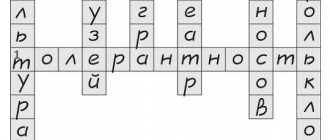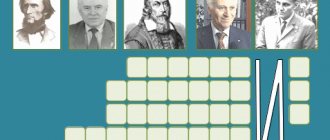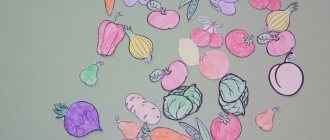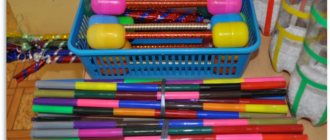Business game for teachers “Educating Russian Citizens”
- September 11, 2020
Competition “Methodological piggy bank of a teacher - 2016”
The business game for teachers “Educating Citizens of Russia” provides an opportunity to conduct testing for teachers, as well as improve the work of preschool educational institutions in the moral and patriotic education of preschoolers, stimulates the need for teachers to demonstrate creativity in the educational process.
Senior teacher . One of the main activities of our preschool institution is “Moral and patriotic education of preschoolers based on patriotism.” Let's look at the terminology: patriotism is love for the Motherland, the Fatherland, one of the deepest feelings, consolidated over centuries and millennia. The goal of teachers’ activities in this area is to create conditions for children to develop love for their small homeland.
Purpose of the game:
1. Improve the work of the MADO in the civic and patriotic education of preschool children. 2. Stimulate the need for teachers to show creativity and introduce new Federal State Educational Standards for the successful education of preschoolers in the form of a competition for teachers. 3. Develop the ability to discuss and agree on proposed issues.
Rules of the game:
1. Take an active part in the game. 2. Be able to listen to others. 3. Develop a general solution to the issue. 4. Maintain a culture of speech and tact. 5. Do not evaluate jury scores.
Attributes:
1. Forms-protocols for the jury. 2. Image of the Coat of Arms and Flag of Russia. 3. Assignment forms. 4. Scheme for the implementation of moral and patriotic education. 5. Audio recording of folk music. 6. Exhibition of methodological literature on civic-patriotic education.
PROGRESS OF THE GAME
Presenter: Today we are playing a business game on the moral and patriotic education of preschoolers. And according to tradition, you and I must split into 2 teams.
1. Game “Let’s stand in twos.”
Goal: distribution of players into teams.
Progress of the game: Music sounds. All players move, and the Leader calls the number 2 (4, 6). Everyone is built in pairs.
Host: You are divided into fours - these will be the teams. I invite the teams to go to their tables. Please choose your team captains and come up with a team name. According to tradition, we need to select the jury for today's game.
1. Training on creating the image “Motherland”.
I propose to create an image of the Motherland.
- close your eyes, imagine the image that appears when you hear the word “Motherland”. (teachers describe the images that arose: birch, open field, etc.);
- exchange opinions, listen to folk songs and watch the video “Pictures of Native Nature”;
- development of a general concept of “Motherland”;
- selection of related words for the word “Motherland” (Motherland, clan, people, parents, portly, beard, spring).
Interesting fact: Beard is a word related to “Motherland”. It has been proven that hair contains the genetic memory of the family. Therefore, a woman wearing a braid should not cut her hair during pregnancy; through the braid, she passes on the ancestral memory to the child. No wonder the braid looks like a DNA helix. And men kept their ancestral memory in their beards. Therefore, in Rus', men always wore a beard.
Returning to the topic of our seminar, “Moral and Patriotic Education,” we can say that each clan, like a people, should have a specific place, its own piece of the Motherland. This is the land from which the family tree grows. And this piece should be passed down by inheritance. It cannot be sold or exchanged. The commandments of the god Perun say: “Do not sell your land for gold and silver, for you will call curses on yourself, and you will not be forgiven all your days without a trace...”
2. Game "Brainstorm".
Host: And now we will do a little warm-up. Answer the questions given to you.
Questions for teachers:
1. How do you understand what moral and patriotic education is? (This is the education of love for the Motherland, oneself, loved ones, the environment).
2. Formulate the goal of moral and patriotic education of preschool children. (Education of a humane, spiritual and moral personality, worthy future citizens of Russia, patriots of their Fatherland).
3. Formulate the tasks of moral and patriotic education of preschool children.
• Formation of a feeling of attachment to your home, kindergarten, friends, your loved ones; • Formation of a feeling of love for one’s native land, one’s small homeland based on familiarization with one’s native nature, culture and traditions; • Formation of ideas about the Motherland as a native country, about Moscow as the capital of Russia; • Fostering patriotism and respect for the cultural past of Russia through the means of aesthetic education: music, artistic activity, artistic expression; • Nurturing a moral and patriotic feeling through the study of state symbols of Russia. • Fostering a sense of respect for elders.
4. Draw up a diagram for the implementation of work on moral and patriotic education with preschool children (educators are asked to fill out the diagrams proposed to them. Then the Leader fills out the general diagram on the board for verification).
3. Game “Attentive Eyes”.
Host: And now we will test your powers of observation and how your moral and patriotic feelings are developed. Remember and answer the questions:
• Describe the coat of arms of Russia. (We don’t know exactly why the tsar chose a combination of white, blue and red colors. Perhaps he used the ancient coat of arms of the Moscow princes: white - St. George the Victorious, blue - the flowing cloak of the horseman, red - the background, the shield of the coat of arms.) • How many crowns do eagles have on the coat of arms of Russia? (Three. They are yellow, and this is the color of the sun. For us, yellow has always symbolized goodness and justice) • What does the eagle hold in its right paw? (scepter) • What does the eagle hold in its left paw? (rod. These are symbols of power) • What else is depicted on the coat of arms? (St. George the Victorious. Our coat of arms symbolizes the victory of good over evil) • What is he holding in his hand? (Spear. From this spear the penny got its name) • What form of object do the coats of arms have? (shield)
Host: And now a question for the most erudite.
• Why did you need to paint the shields? (distinguish between knights dressed the same). • What is depicted on the coat of arms of Art. Konstantinovskaya? (green field, river, fortress, sword with wings - symbol of the Archangel Michael) • What do they mean?
Host: Let's check the correctness of your answers (shows an illustration of the Coat of Arms of Russia, the coat of arms of the village).
4 “Let us remember the history of our village.”
Host: In what year was our village created? (1847)
• Name the memorable and historical places of our village. • Name the oldest buildings in our village. • What were the names of the enterprises in our village? • Name the heroes of our village, past and present.
5. Presenter: What should the subject-developmental environment of groups for the moral and patriotic education of preschoolers include in the light of the Federal State Educational Standard?
6. Presenter: Name what types of activities for the moral and patriotic education of preschoolers can be carried out in educational areas in accordance with the Federal State Educational Standard.
7. “Grandma’s chest”
Host: Name as many proverbs and sayings about the Motherland and family as possible. For each answer the team will receive a point.
Presenter: What are the names of the poems about the Motherland and family. The team will also receive points for each answer.
8. Collective creative work “Collage “We are Russians”.
Teachers are creating a collage that will be used in the thematic exhibition “Our Motherland – Russia.”
Host: And now the jury will sum up the results of our business game.
Bibliography:
• Aleshina. N.V. Patriotic education of preschool children. – M.: TsGL, 2004
• Belaya N.B. Pedagogical council in a preschool educational institution: Preparation and conduction. – M.: TC Sfera, 2004 (Series “Library of the head of the preschool educational institution”
• Loginova L.V. What can the coat of arms tell us (Non-traditional forms of work with preschoolers on patriotic education.) - M.: “Publishing house Scriptorium 2003”, 2006
• Magazine “Preschool Pedagogy” No. 10, 2012.
Author: Mikhno Lyubov Nikolaevna, senior teacher of MADOU No. 24, Art. Konstantinovskaya, Krasnodar Territory, 20 years of teaching experience, 3 years as a senior teacher.




